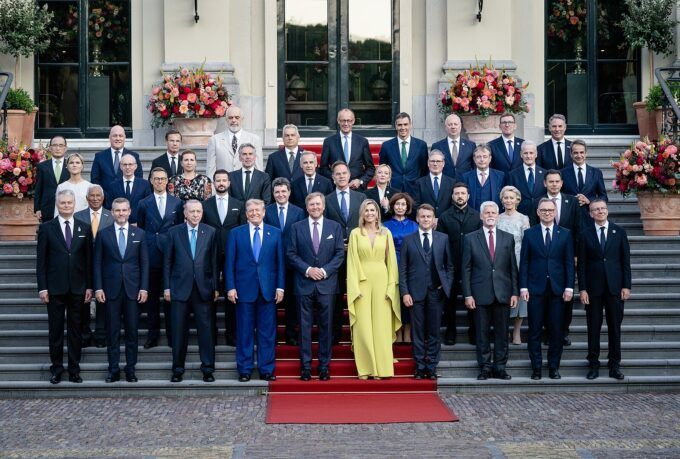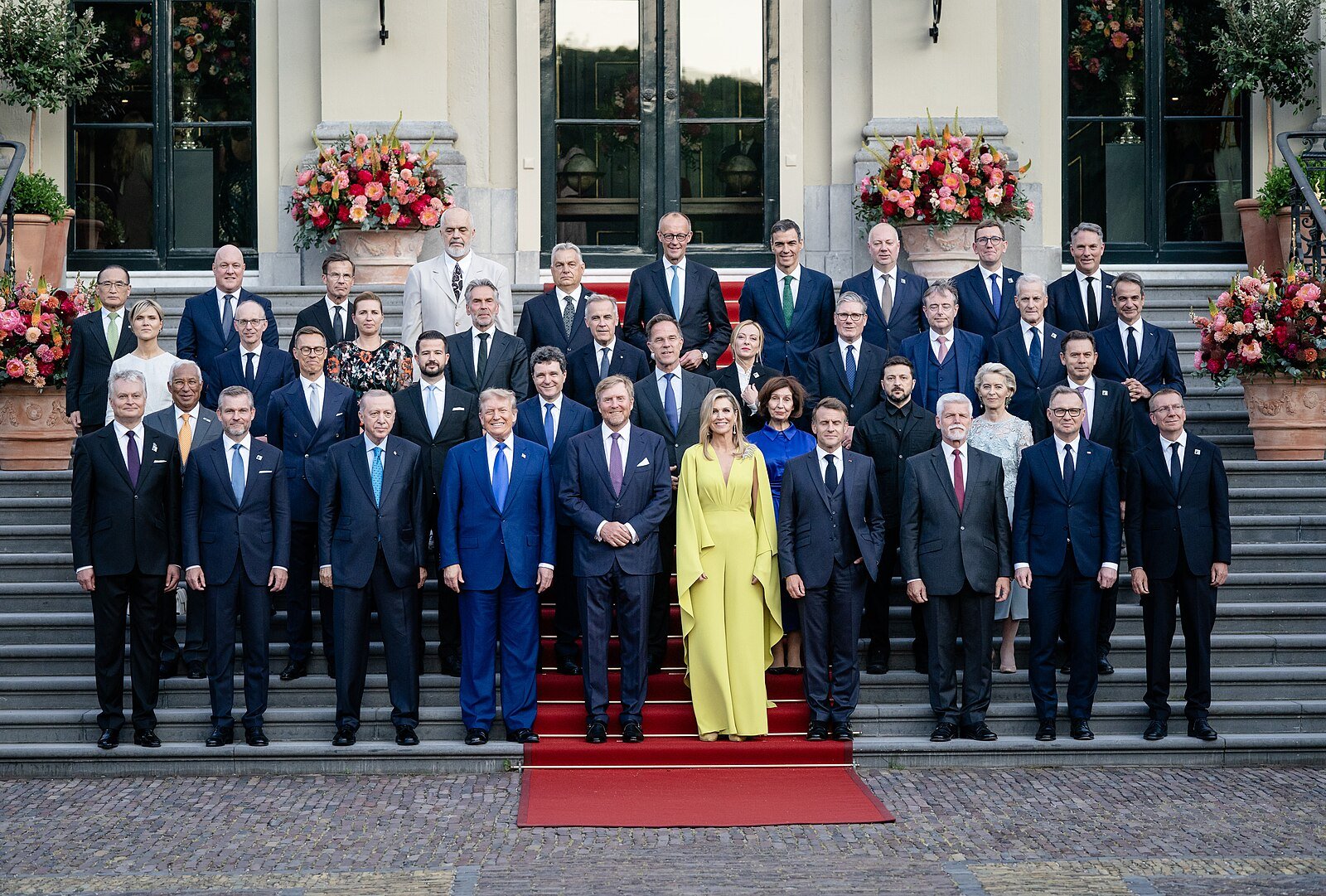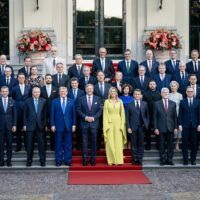
Photograph Source: Bart Maat – CC BY-SA 4.0
Donald Trump is embracing new military goals for NATO that may lead to an additional trillion dollars in military spending and the greater militarization of Europe.
In pressuring the members of the North Atlantic Treaty Organization (NATO) to vastly increase their military spending, the president is setting Europe on a pathway to becoming a major center of military power. Although a far more militarized Europe holds great dangers for the world, including a greater risk of war, the president is boasting about his move, enthralled by how much more money European countries are pledging to spend on their war-making capabilities.
“It’s over a trillion dollars more a year,” Trump marveled at a June 27 press briefing. “Think of that, a trillion dollars.”
Trump’s Position
Since rising to power, Trump has made it one of his primary goals to make European countries spend more on their militaries. Claiming that he is putting America first, the president has demanded that European countries rely less on the United States for their security and take on greater responsibility.
Trump has focused his efforts on NATO, the transatlantic military alliance that is led by the United States. Unlike other U.S. presidents, who have embraced the alliance as a tool for reinforcing U.S. military power and maintaining U.S. dominance over Europe, Trump has criticized the alliance as a way for Europe to take advantage of the United States.
At the core of Trump’s critique has been military spending. One of his constant complaints has been that the United States spends far more overall on its military than other members of NATO. Rather than calling for reductions in U.S. military spending to achieve parity, however, Trump has pushed for a record-setting trillion dollar Pentagon budget while demanding that NATO members increase their military spending.
One of the ways in which Trump has pressured NATO countries to increase their military spending is by equivocating on U.S. treaty obligations. Repeatedly, Trump has indicated that he will not uphold the North Atlantic Treaty’s Article 5 to defend member states under attack, just as the European powers did when they came to the assistance of the United States after 9/11.
“If they don’t pay, I’m not going to defend them,” Trump said in March.
Another one of Trump’s moves has been to exploit past commitments by member states to increase their military spending. During his first term, for example, Trump demanded that each NATO member achieve military spending of at least 2 percent of its gross domestic product (GDP), a target that NATO had established in 2014 as a long-term aspiration.
Since the start of his second term, however, Trump has demanded even more of Europe, urging NATO countries to increase their military spending to 5 percent of their GDP. Although the United States will not meet Trump’s threshold under its new Pentagon budget, Trump insists that all other NATO members must meet the target.
“I don’t think we should, but I think that the NATO countries should, absolutely,” Trump told reporters on June 20.
Long-Term Implications
Despite the fact that several U.S. leaders have been wary of Trump’s tactics, especially the manner in which he has berated Europe, they have remained quiet about the potentially dangerous long-term consequences of a more militarized Europe. As officials in Washington are well aware, Trump’s moves to militarize Europe put the people of Europe and the world at great risk.
One of the major risks to the people of Europe concerns social spending. If Europe follows through on its new military commitments and starts investing vast sums of money on its war-making capabilities, then it may try to offset costs by cutting social programs.
In a June 25 interview with Politico, Secretary of State Marco Rubio pointed to the possibility of reductions in social spending when he indicated that Europe’s “vast social safety network programs” may be at risk. Every dollar “spent on military is money you’re taking away from education, health care, all the stuff that people have come to benefit from in your government,” Rubio said.
Another danger is that Europe may become more prone to war. With greater military capabilities, European powers will find it tempting to increasingly turn to war and aggression, just as they had done during the early twentieth century, when they led the world into two catastrophic world wars.
“We are in an era of rearmament,” Ursula von der Leyen, the president of the European Commission, declared in March. “And Europe is ready to massively boost its defense spending.”
With Europe moving into an era of rearmament, there’s also a greater risk of war with Russia. Not only will an additional trillion dollars in military spending have serious consequences for the war in Ukraine, which continues to suffer from a tremendously violent war with Russia, but such a vast increase in military spending is likely to inflame tensions with Russia, which views NATO as a security threat.
One of the most tragic ironies of Trump’s approach is that he is militarizing Europe at the same time that he is blaming NATO for the war in Ukraine. Repeatedly, Trump has claimed that the United States bears responsibility for the Russian invasion due to its efforts to bring Ukraine into the military alliance.
“I believe that’s the reason the war started,” Trump said in February.
Beyond the dangers of militarization for Europe, there’s also a major risk to the people of the world. If Europe takes on a greater military role within NATO, then the United States will be better positioned to shift more of its military assets to other regions.
In fact, the Trump administration has repeatedly indicated that it is pushing for an increase in military spending in Europe so that the United States can send more of its military assets to the Pacific, where it is directing a military buildup against China.
“As our allies share the burden, we can increase our focus on the Indo-Pacific, our priority theater,” Secretary of Defense Pete Hegseth explained in May.
With the United States moving toward a greater militarization of the Pacific, where it already maintains a massive military presence, the world will face one of its greatest long-term dangers. As things now stand, the United States is preparing for a future in which there may be a great power war on two fronts: one in which Europe wages war against Russia and another in which the United States wages war against China.
“The motto of my first platoon, first one I led, was: ‘Those who long for peace, must prepare for war,’” Hegseth said. “That’s exactly what we’re doing.”
More Pathways to War
With its campaign to pressure Europe into committing an additional trillion dollars to military spending, the Trump administration is making a dangerous gamble. Not only is it laying the groundwork for Europe to become one of the world’s major centers of military power, but it is risking more military conflict.
The Trump administration’s approach requires greater militarization in Europe and the Pacific. With Europe embracing a new era of rearmament and the United States directing a military buildup in the Pacific, the transatlantic allies are likely to provoke Russia and China, both of which will face pressure to act.
At the same time, the Trump administration is creating more pathways to war. In pushing for the militarization of Europe, the administration is positioning Europe to take the lead in directing more military operations against Russia. By shifting more military assets to the Pacific, the administration is preparing the United States for multiple military scenarios against China.
Officials in the Trump administration may defend their actions as a matter of deterrence or an effort to achieve peace through strength, but what they are really doing is destabilizing the world. Rather than making a dedicated commitment to finding diplomatic solutions to the world’s most pressing problems, the Trump administration is making a long-term commitment to militarization and war, all with great risks for Europe, the United States, and the world.
This first appeared on FPIF.
The post Trump Trillion Dollar NATO Gambit appeared first on CounterPunch.org.



